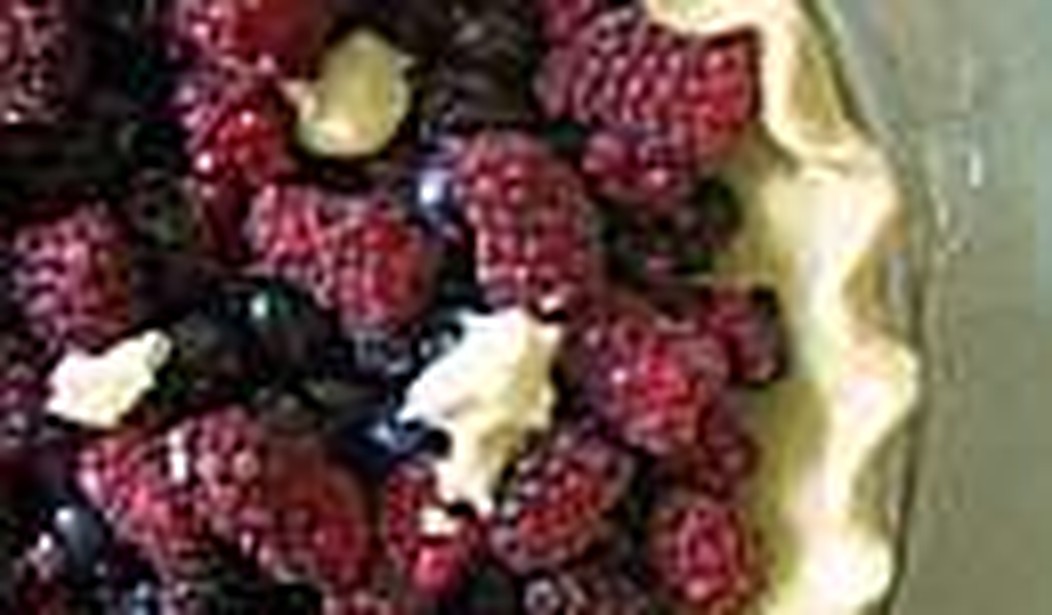Pie
Oh my.
Nothing tastes sweet,
Wet, salty and dry
All at once so well as pie.
Apple and pumpkin and mince and black bottom,
I’ll come to your place every day if you’ve got ’em.
Pie
Song to Pie, by Roy Blount Jr.
There is both truth to the saying, “easy as pie,” and one huge assumption.
Certainly, it’s no work to mix fresh berries with sugar and bake it up.
The trial, of course, the hurdle and the bane of bakers everywhere, is the crust.
We try to work around it. We buy store-bought; we make it out of graham crackers; we sensed salvation when the Cuisinart came along and promised crust could be made at the touch of a button, just whomp flour and fat and water around until it comes together in a ball.
This, for the most part results in thick pale dough with zero flakiness; a cardboard crust whose bottom remains a white sog in the pan after the pie has been served; really, who wants it?
In truth, flakiness was something I’d heard about but never experienced until I met my husband, whose mother, a crack baker, served me a slice of her homemade cherry pie. It was superb, as was the crust – browned and flaky and sandy and delicate. More, not one iota of it was left in the pan, as everyone at the table, and perhaps mostly me, scavenged every morsel.
I asked for the recipe, which had been her mother’s. It’s a “human hands must not touch this dough!” affair that requires that flour and shortening be twisted together in a tea towel, at which point enough of a dough is said to form and thus allow itself to be rolled. In ten times of trying, this has for me only once been the case. Instead, I wind up with 100,000 shreds of dry dough that I laboriously press into a pan; flour on every surface of the kitchen, and a tea towel so gummy it must be thrown out. There had to be a better way to build a piecrust.
And so, when San Francisco pastry chef Shuna Fish Lydon came to Portland to teach a series of piecrust classes, I signed on. Not merely because I thought she might help me build a better pie, but because I am a fan of her blog, Eggbeater, wherein she deconstructs pastry with the intense specificity of Howard Roark talking about the Wynand Building.

“You need to know how the protein content in flour determines the structure of pastry, and also, how this is all dependent on heat,” Lydon was saying, when I walked into the class five minutes late. A pixyish dark-haired gal, Lydon was standing inside a semi-circular island at a local cooking school, being listened to by ten women wearing aprons they’d brought from home. Before them were rolling pins, pie tins, and kitchen cloths, and all were scribbling in pads, trying to learn the secrets of perfect piecrust, which, according to Lydon, are many and immutable.
“First of all, you need to use all-purpose flour,” she said, pouring a small pyramid of White Lily flour -considered, amongst serious bakers, to be the king of flours-onto a stainless steel island. “It used to be really hard to get White Lily, which is milled in Tennessee; I’d have friends smuggle it to me in their suitcases, but it’s easier now. The reason you use all-purpose flour is, pastry flour is too soft to support the structure you need, and bread flour is too high in gluten; you’ll wind up activating too much of it and getting a tough crust.”
As for fat, Lydon was today using butter. While she said she has some regard for lard, “it’s hard to get the really flavorful and fresh lard, which is leaf lard,” which is harvested from around hog kidneys, and which, Lydon said, “not that many butchers carry.” As for solid vegetable shortening, forget it. “I don’t want to bake with anything I don’t want to eat,” she said. “This has nothing to do with good or bad fat and everything to do with taste – do you want to eat a big spoonful of Crisco?”

Next component: cold. “Everything cold,” said Lydon. “Flour, butter, bowl, paddle.” She pulled each of these out of the freezer, as well as a cup of water frozen near-solid. “You know when a recipe said, ‘ice water’? It means, ice water. Okay, gather round.”
We stood around Lydon as she affixed the paddle attachment and mixing bowl to the Kitchen-Aid, dumped in the flour, a little sugar; a little kosher salt. On went the mixer and in went the butter, pre-cut in ¾-inch cubes.
Lydon asked, “What do the recipes usually say; to mix the butter and flour together until it looks like…”
“Cornmeal,” answered the class.
“Right. And that is way too much.” She stopped the mixer. “You want it to look like this.” It was golden and crumbly, full of irregularly sized blobs of butter, some the size of quarters. Lydon had us each of us “pinch and release” a bit of dough, which held together, but not too much.
“What else to do notice about it?” she asked.
“That it’s cold,” said someone.
“Right, and it’s about to get colder.” Lydon added just a bit of the water, with the mixer running, and then, turned it off. “If you make the dough too wet; it’s garbage,” she said. “Put yourself and the dough out of your misery and throw it in the trash.”
The dough Lydon had made looked veritably living, buoyant and springy, more like tiny squiggles of uncooked spatzle than a big blob of dough. “It shouldn’t hold together, not really,” she said. “If it does, you’ve over-mixed, activated the gluten, and will have a tough dough.”
Lydon spent the next ten minutes going deep, about how the butter and flour have to form a puzzle sequence, with the butter molecules surrounding the flour molecules surrounding the butter surrounding the flour ad infinitum. She talked about how “butterfat is traded on the open market, like diamonds.” How cream has a higher fat content in the summer, because of what the cows eat, so, your butter will be different, and you’ll have to make allowances, and personally, she likes Irish butter. How you should always make your crust early in the morning or at night, because you don’t want it to get hot, which means your hands, too, should always be cool; rinse them under cold water before you start to work dough. And of course, the dough needs to rest, in the refrigerator; piecrust loves cold because it slows down the production of gluten and allows all the nice little pockets of flour and butter to form.
And while it might have been so much arcana to someone uninterested in pastry, to the class, it was manna.
And then it was time to roll. She handed us each some dough she’d pre-made, and had us set up our stations. “Sprinkle the flour for your rolling surface from a great height,” said Lydon, letting a shimmer of flour float down into her work surface. She cautioned us about putting too much pressure on the rolling pin with our dominant hand; showed us how to flatten the dough by quarter-turns; how to run an offset spatula beneath the dough to keep it from getting stuck.

“If your dough is stuck, you’re sort of f***ed,” she said. “So, keep turning it, keep a little flour under it, and roll it to an even thickness.”
Pie pans should, she said, be kept in the freezer. Ours had not been, but that was okay, as were all our rolling efforts; I was amazed to see ten truly nice circles of even thickness.
“Dust off any excess flour with your pastry brush,” said Lydon, showing us, also, how to fold the dough in quarters and dust off all excess flour, then place the quartered dough in the tin, unfold it, and flute the edges. Here, too, all the women seemed eminently capable: We trimmed excess dough with a scissors, crimped the edges, and, voila, beautiful crust, especially from a participant named Denise. So round! We all said. So buttery!

“At this point, you would, of course…” Lydon prompted.
“Put them in the freezer to rest,” we said, taking off our aprons and standing, proprietarily, next to our crusts.
The proof, of course, was in the tasting, which Lydon had seen to, pulling from the oven a mixed berry pie she’d made that day. “I don’t like a lot of sugar in my fillings, I like to taste the fruit.”
Clearly, so did we all, as we scarfed down slices of pie, paying particular attention to the crust, which was crisp and flaky and delicate and buttery. Everything a crust should be.

“Color is flavor, remember,” instructed Lydon, as she wiped down the counters and watched us enjoy our pie. “And cold is your friend.”
Shuna Fish Lydon’s online pie tutorial can be found here.









Join the conversation as a VIP Member